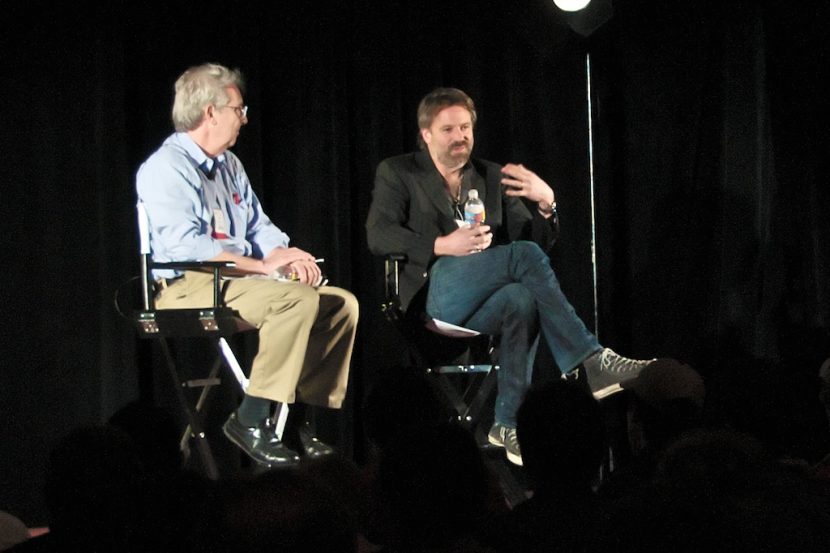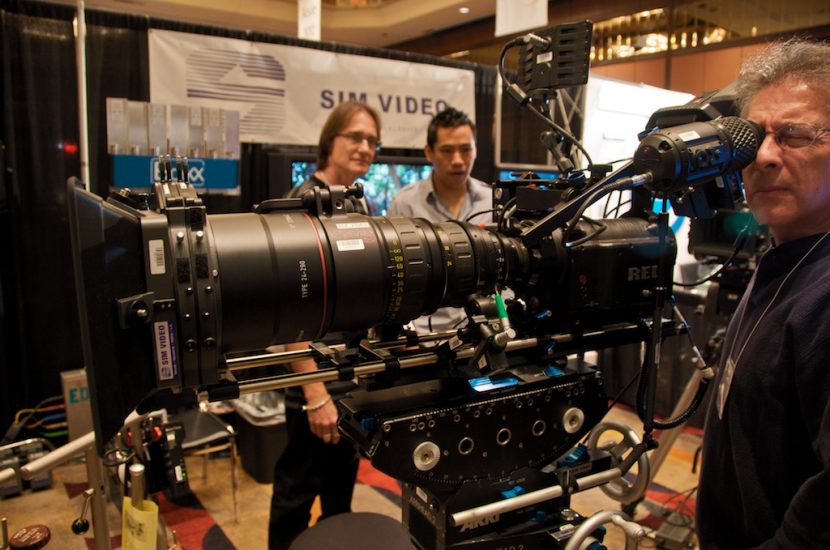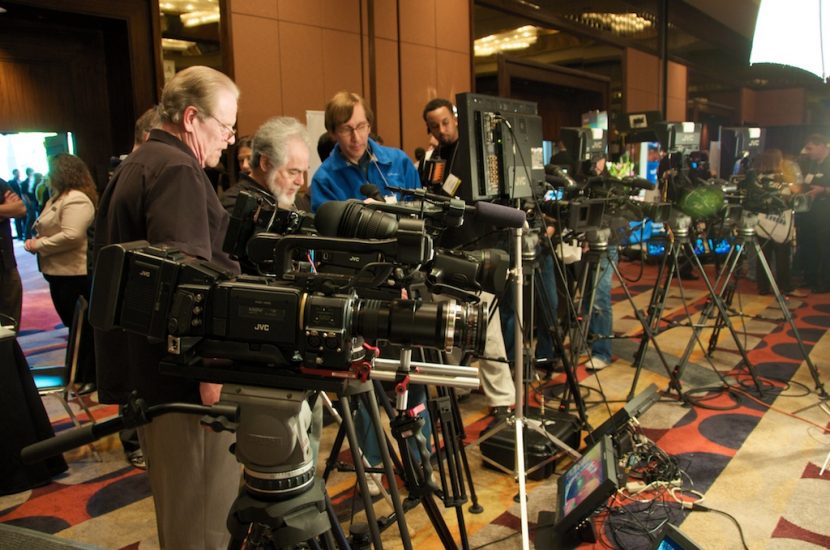HD Expo has been around since 2001 and holds conferences in Los Angeles, Chicago and New York as well as internationally. Kristin Petrovich, President of HD Expo explained that they are in the process of transitioning the name to “creatasphere”.
On March 5th the HD Expo was held at the Hilton at Universal City, featuring an exhibit area and sessions ranging from ones on the RED camera to others by Adobe, Panasonic, a session about Indie Filmmaking, among others.
The keynote was titled “The Cinematographer as Artist, Expert, Collaborator”. This was to be a conversation with Cinematographers Wally Pfister (“Dark Knight,” “The Prestige,” “The Italian Job”) and Dion Beebe (“The Memoirs of A Geisha,” “Chicago,” “Miami Vice”). Dion Beebe was unavailable, leaving it to Wally and Moderater Peter Caranicas, Managing Editor, Variety. As Wally Pfister was unable to attend the VES/ASC event last week it turned out to be a good session for filling in some pieces in the story we did on that event.
A conversation with Cinematographer Wally Pfister
Peter Caranicas started the session with a bit of humor, asking Wally Pfister “what was it like working on set with Christian Bale?” referencing the infamous audio clip from the set of Terminator 4 where Christian dressed down the DP. Wally has done four movies with Christian and was a good sport to take this question (Peter had cleared the question with him in advance). He said that Christian is a friend, a pro, and he has always enjoyed working with him.

8mm to IMAX
In the recent best selling book “Outliers” Malcolm Gladwell offers that the year you were born has an impact on your success in an industry – for example Bill Gates and Steve Jobs were born the same year and therefore were in the right place on the timeline for the birth of personal computers. I was reminded of this premise when Wally answered a question about getting started with film. His answer, that he took advantage of his father’s underutilized 8mm film camera, seems to be a common answer when talking to filmmakers born to a time where 8mm was new and home movies were popular.
He talked about the magic of sending the film off to Rochester for processing and waiting 5 days to see the results. When they were working with IMAX on “Dark Knight” director Christopher Nolan joked that shooting IMAX was much like shooting super 8… you had that 5 day wait for processing and they both held 3 minute loads of film.
There is around 36 minutes of IMAX footage in “Dark Knight” and he estimated the cost is 3 times the amount for 35mm for film stock and processing. There was a lot of handheld photography in the film and Christopher Nolan pushed Wally to do one shot in IMAX handheld, not an easy feat due to the bulk of the camera, but they came up with a special rig (“almost broke my back”) and did manage one shot, just to say they had done it. He raised some of the issues of shooting IMAX… the camera is large, it is also noisy requiring any audio to be dubbed later, and as mentioned earlier the size of film loads is very short. During their prep work for shooting with the camera IMAX warned them that it would take about 15 minutes to reload the camera. This is murder on a film set but they were able to build up speed as they went along – he estimated they were down to 3 to 5 minutes and joked that Christopher Nolan could probably tell you, to the second, how long it took to reload.
Follow Through Post
An issue we heard about at the VES/ASC event was that of Cinematographers not getting paid for post production. It has long been tradition in films that they supervise that process, but they are not paid for it. What used to involve a few days of color timing can become months in a DI suite, and this has made payment a rising issue. Wally said that it’s a matter of maintaining control and that they will need the support of Directors to get paid for this part of the project. Interestingly “Dark Knight” was a photochemical finish, not a DI. He said they reviewed dailies on film and he never saw anything on video (compare this to the comments at the VES/ASC event). He is worried that this is coming to an end but Christopher Nolan likes to work this way and added that “when you make the studio a billion dollars, you can tend to be able to work the way you like”.
Answering a question about the post process and DI he told the story of being on a panel recently where everyone else had done a DI and were happy with the results. Afterwards, he was walking with one of the other panelists who got a call about some major color issue with files that had not been sent out properly. Wally offered that with a film master you know what you have, that printer lights will be universal, where the digital workflow is not as absolute and commented “it’s fine to take a leap in technology as long as it’s an advancement”.
Digital Cinematography, Stereoscopic
Discussing moving to digital he was excited about being able to get cameras in places where traditional film cameras cannot be used. He mentioned a Nike commercial he recently directed where they mounted a lipstick sized Iconix camera on Swiffers as a case where digital enabled him to get something he could not achieve with a film camera. “We don’t need a Digital Camera if it is the same size as a 35mm film camera, but offers lower resolution”. In talking about image quality he also championed scanning film at 8k to capture all that is in the film. He mentioned that certain directors like David Fincher prefer digital to allow the camera to roll longer to help capture Actors performances with less interruptions.
Two other questions were reminiscent of the VES/ASC event. He was asked if he thought Stereoscopic was a flash or the future. He said he loved stereo on an attraction at Disneyland where it enhanced an experience, but questions the application of stereo to all film – “does it enhance the storytelling or is it a distraction”? This conversation invariably turns to a mention of James Cameron’s coming film “Avatar”, which he mentioned, and said he is reserving judgement on the technology until he sees that.
Where will be be in 20 years?
A great question came from the audience about what he sees for the business thinking forward 20 years. He reminisced about starting in the business shooting video 28 years ago with an RCA TK76 and 3/4″ videotape, so looking at how we have progressed from then in about that same timeline was interesting to him. He thought that in 20 years film is probably gone, but he hopes he is wrong. He hopes that we get a great “lump of clay” that we can create great images with, smaller cameras – the size of his thumb, and he hopes that the theatrical experience remains. In a bit of irony he went on to mention that he is building a great home cinema and admitted that during awards season he was only able to make it to one theatrical screening and ended up watching the rest of the films via DVD screeners.
Local 600
Steven Poster, President of the Local Union 600 (International Cinematographers Guild) asked him to talk about about his membership in the union. Wally talked about how as a young person he was able to get into the guild and this enabled him to get health care and a savings plan for retirement. He mentioned how the lack of unions in the UK has really affected working conditions in the film industry there. This seemed like a topic that would make for a good panel on it’s own, perhaps at a visual effects conference.
This was just one of the many sessions at this HD Expo, you can get an idea of the variety of topics offered by looking at the schedule, here or here for a list of exhibitors.



Great job on this Jeff. Very accurate. Thanks!
Wally
[…] Even the experts themselves are unsure with one of the leading cinematographers, Wally Pfister, questioning the application of stereoscopic 3D to all film asking “does it enhance the storytelling or is it a […]